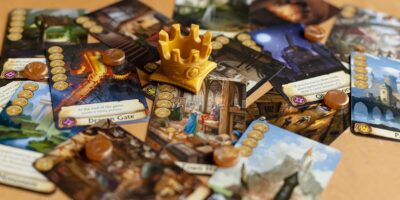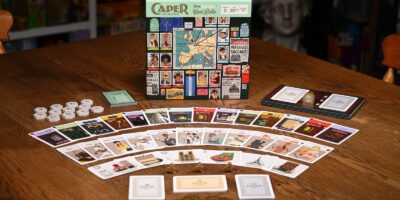In the fall of 2009, I stumbled across a little series known as Fatal Frame while browsing my dial-up internet one day after school. Having recently played (read: watched my friend play it through occasionally covered eyes) SILENT HILL 2 and been exposed to a big, bright world of horror gaming, a Google search boldly proclaimed Fatal Frame as another franchise in the pantheon of the greats. Over the course of the next three months I spent almost 200 dollars accumulating the rarely-printed original trilogy, dropping almost the same amount of money a few years later on the Japan-exclusive fourth installment you could only play in the US via a Wii hack (but that’s a story for another time).
This was an astronomical amount of money to sink into the franchise back when I was on a $20-a-week allowance, so I was eager to boot up the first game, only to find it . . . too fucking scary to play. Between the sound design, the jump scares, the morbid backstory, and the nerve wracking game mechanic wherein you have to carefully track and focus in on malevolent spirits via a camera lens in order to defeat them, FATAL FRAME was set aside after the scant 20-minute intro. Of course, later years would see a braver me able to almost beat most of the games (which doesn’t sound all that impressive now that I’ve written it out), but I’ll never forget that visceral sense of unadulterated fear and dread that gripped me that one night in September. It was a feeling I had forgotten until booting up WHITE DAY: A LABYRINTH NAMED SCHOOL almost exactly eight years later.

Reading these positive reviews of MOTHER! like . . .
Having existed in some form or another for 16 (!) years, the original WHITE DAY terrified PC gamers almost exclusively from Korea as far back as 2001, with little fanfare outside of its immediate geographical neighbors. Then taking the strange career trajectory of a re-envisionment on mobile phones in 2009, the game would be spruced up yet again with an impressive 3D Android remake for Korean audiences in 2014. While this included an English-language version for international markets, It wasn’t until this past month that the new White Day saw a wide release, with a PC and PlayStation port to more comfortably welcome its American and European audiences, considering the fact that mobile gaming isn’t nearly as prevalent on the other side of the Pacific.
The story starts off deceptively pleasant and, dare I say, cute as we’re treated to a sunny prologue: Lee Hui-min is the new kid on the block and has been cultivating a massive crush on high school hottie Han So-young. Luckily for him, White Day, the East Asian-equivalent of Valentine’s Day, wherein boys express their feeling for girls via the requisite small gifts, is the very next day. Hui-min decides to sneak into Yeondu School that night and leave a White Day surprise on So-young’s desk, currying extra favor by also returning her diary that she dropped. As we all know, no good deed goes unpunished, and Hui-min’s plans quickly go to the birds as the door menacingly locks behind him of its own accord and he’s forced to survive the night in a school full of vengeful ghosts and ghouls that want anything but.

She seems sweet
The phrase “hidden gem” has become blasé through overuse, and I and many other writers at Crossfader are certainly guilty of propagating its prevalence. But really, almost nobody in this country has heard of WHITE DAY: A LABYRINTH NAMED SCHOOL, and while it’s certainly not perfect, its cultural obscurity and sheer, unfettered entertainment value make it a top contender for actually deserving to be referred to as such. That being said, it’s also worth pointing out what WD: ALNS is not: the comparisons that seem to be thrown around relating it to Fatal Frame, admittedly why my interest was first piqued, are almost entirely incorrect apart from the fact that both feature Asian protagonists and are horror games. I personally think it’s more in line with January’s excellent DETENTION, but our esteemed gaming editor insists only “hide and seek” thrillers like OUTLAST and AMNESIA: THE DARK DESCENT are relevant reference points. Regardless, it’s well worth approaching WD: ALNS as a game of more-or-less singular aesthetics and experience, which will ultimately yield larger rewards, especially considering its initial release date.
At some point horror media must be boiled down to the age-old question of “Is it scary?” And in the case of WD: ALNS, the answer is a resounding fuck yes. Right off the bat, the impeccable sound design and soundtrack deserve their time in the sun. With a core layer of non-diegetic, vaguely tribalistic vocal moans, windows shake, floors creak, and every so often a pulsing rise in atmospheric intensity occurs for no immediately apparent reason, ensuring that there’s never a moment where you’re convinced it’s safe to be out and about. Coupled with the higher difficulty levels’ propensity for having lights suddenly go on and off as a marker of ghostly activity, taking a step in any direction has you biting your nails, certainly not abetted by the fact that the game has a seemingly randomized mechanic for liberally sprinkling in screamers.

Not sure who the Beta Boyz are, but I’m sure they were scared too
The creatively-named “Haunted Head Ghost” is first encountered towards the end of the “first act,” and heartbeats will race as a horrifying face rushes to fill the screen accompanied by a tortured scream. From this point on it’s off to the races, as the harder difficulty levels have her constantly track the player, making it literally impossible to catch your breath. This is admittedly contentious, as some horror fans could construe it as “cheap,” but I’ll be damned if it’s not effective. If I’m experiencing physical dread at the thought of continuing to explore because the game is too nerve-wracking for casual perusal, I believe it’s done its job. That being said, the game is rather skimpy in terms of its inclusion of less pervasive ghostly threats. Almost no spirits apart from a core roster of a few mini-bosses appear in any difficulty lower than hard. This encourages replay value in order to catch ‘em all, and forces you to more carefully explore in the hopes of obtaining items and collectible rumors and ghost stories that will hint where to find them, but is a little disappointing for veteran horror buffs. Nevertheless, WD: ALNS manages to make itself layered by also incorporating a more corporeal threat in the form of The Janitor.
Either possessed or driven mad by his nights spent alone in Yeondu, an early cutscene has Hui-min quaking in fear as he witnesses The Janitor throw a hapless after-hours student to the ground and beat him to death with a baseball bat. It’s shocking, and admittedly a little bit darkly humorous, but all smiles will disappear as a constant game of cat-and-mouse occurs that has the frustratingly sprightly Janitor chase you around the halls, forcing you to crawl into dark nooks and crannies to escape his wrath, often throwing you into supernatural threats that you wouldn’t have otherwise experienced. If it’s not clear by now, this game is really, really tense; however, it must be pointed out that once you’ve spent an hour or 10 acclimating yourself to the atmosphere, things tend to err on the side of frustration when backtracking is on the table, as The Janitor doesn’t shake up his AI and will continually hound you regardless of your progress in the story.

Sometimes wearing a jaunty gib to boot
As with Haunted Head Ghost and all other enemies encountered, another key facet of WD: ALNS is the fact that Hui-min is entirely unable to go on the offense, having to constantly run, hide, or get creative with environmental factors that can harm his assailants. This is a refreshing change of pace from the typical horror game that errs on the side of overpowering you, and while the more mature tension of Resident Evil-like ammo conservation is absent, it still does wonders for the experience to have your character be much weaker than the antagonists. But fear not, some strategy for survival is still required, as health items are only purchased through coins you may chance to happen upon during your exploration of Yeondu, with saves also entirely dependent on your ability to sniff out the location of felt-tip pens. This can push things into the realm of the frustrating with the increased risk of damage that correlates with the increased prevalence of ghost activity on Normal difficulty and above, but the experience is already so masochistic that anyone who bothers to stick around for the tour of Hell that’s Hard mode knows what they’re getting themselves into.
All these extolled praises aside, WD: ALNS is not without its faults, virtually all of which revolve around the story. It’s just not that good anyway you slice it. While the general premise is acceptable, if a little goofy, the game fails to incorporate its basis in East Asian mythology and spirituality in a way that feels earned or cohesive. The general gist is that the school was built on a site of powerful qi, which already has a large amount of potential danger associated with it, but things got even worse when Yeondu was used as a prison camp during the Japanese occupation of Korea and a hospital during the Korean War. Clearly a place of unrepentantly bad juju, paranormal occurrences also lead students and teachers to ritualistic murder and suicide. If this sounds somewhat vague, it’s because it is; while scattering various documents that slowly chip away at revealing the story is a way to increase replay value, it also never manages to make its more intricate aspects feel necessary, as you can beat the game with maybe a quarter of a grasp on what’s actually going on behind the scenes. As such, gamers only in Yeondu for a quick ride on the merry-go-round have a larger risk potential in terms of finding things unsatisfactory. There is certainly precedent for this sort of structure in video game history, but WD: ALNS really does need roughly five or six playthroughs and branching path explorations to acclimate the player within the environment and narrative. Don’t get me wrong, simply needing to escape a sticky situation is a horror archetype that will float for time immemorial, but the game’s half-hearted attempts at trying to establish itself as something more while never insisting on consideration of such are easy fodder for criticism.
The more immediate story is also impacted by Hui-min’s relationship with the two other hapless students stuck in Yeondu after hours. Oh yeah, I forgot to mention . . . WD: ALNS is also a “dating sim” of sorts. To offer brief moments of respite, Hui-min occasionally stumbles across Seol Ji-hyeon and Kim Seong-a, who are both poking around the school for their own ghost-related motives. While it would really have been impressive to have a straight-laced dating sim occur during the daylight hours at Yeondu and find ways to have the trio return to face the horrors of the halls at night, we’re still left with fun umbrella arcs where your conversation choices with the two affect which of the multiple endings you receive. The shy and timid Ji-hyeon is clearly the one whose friendship pays off later down the line, although the tsundere appeal of Seong-a is the more immediately satisfying path to go down, and her backstory is far more layered and sinister than initially meets the eye. (Fun fact for the nerds out there: the game director has specifically stated that Ji-hyeon is modeled after NEON GENESIS EVANGELION’s Shinji in terms of characteristics, while Seong-a is designed after Asuka.) Nevertheless, the inclusion of the pair adds a more human layer of relational tension to the overstuffed paranormal narrative, and if fully explored, makes the game a more rewarding experience. And yes, you can unlock sexy costumes for them.

Take note of “DLC” and make your own distasteful caption
Although occasionally frustrating and unnecessarily obtuse, in terms of its existence as an unsung highlight of the horror canon, WHITE DAY: A LABYRINTH NAMED SCHOOL proves itself a property well worth seeking out. If you can manage to sign off on not really understanding what’s happening (which, to be fair, is fairly par for the course in the genre), you’re sure to have several late nights spent on the edge of your seat, regularly yelping in terror. The remake justifies itself through its much-needed updating of environmental graphics, and does a bang-up job of bringing the franchise to a horror-hungry Western audience that is sure to appreciate it. Don’t call it comparable to Fatal Frame, but with further patches WD: ALNS is only going to get smoother, so dig in while it’s hot.
Verdict: Recommend
Reviewed on PlayStation 4















Comments